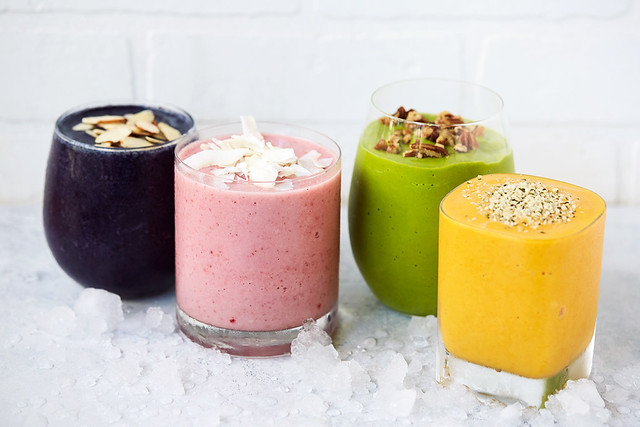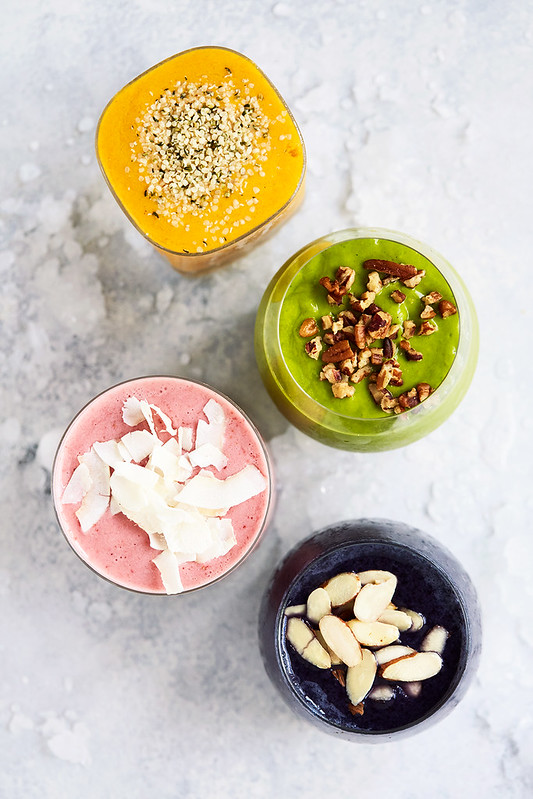While smoothies have become a popular meal replacement, snack and all around trendy food, crafted incorrectly you can be consuming a sugar-loaded, blood sugar exploding cocktail. I am excited to share with you A Guide to Smarter Smoothies to hopefully help you understand how to better create the smoothies that are right for you.


If you’ve been reading Tasty Yummies for some time, you probably know that the archives are LOADED with smoothie recipes. Smoothies used to play a much larger role in my daily diet routine, for the longest time it was always my favorite way to start my day. Interestingly at the height of my smoothie consumption, weight loss was definitely a struggle, as were energy crashes and sugar cravings. What I didn’t know back then, but I do know now as a Nutritional Therapy Practitioner, is that without the proper formulation, smoothies are a blood sugar explosion waiting to happen.
Every time you consume any carbohydrates and sugar containing foods, it causes an increase in blood glucose. How much so is dependent on the food and the individual. Simple sugars more specifically (monosaccharides), those sugars ending in -ose, sucrose, glucose, fructose, lactose, galactose, maltose – these are metabolized especially quickly and can often cause a big surge in insulin.
Our body’s innate intelligence continually monitors the amount of glucose in our bloodstream to maintain balance and homeostasis. When blood glucose levels increase, the pancreas releases the hormone insulin. Insulin increases the uptake of glucose by our muscle and fat cells; increases the amount of glycogen in our muscle and liver; increases fatty acid synthesis from excessive carbohydrates; and decreases fat breakdown and mobilization from our fat tissue.

How Bad Can a Fruit-Loaded Smoothie Be?
With a spike in blood sugar, a release of insulin and the impending crash, no matter what food is the initial cause, this can lead to immediate hunger, mid-day cravings, energy crashes, lightheadedness, anxiety, etc. Even worse, if the rest of your day’s eating (and most days) continue on the carb and sugar path, you are absolutely creating a long term problem. Whether you are overweight, struggle with weight loss or notice blood sugar issues or not.
Day in and day out this roller coaster can lead to a slew of health complications beyond obesity, lethargy and cravings. To simplify the worst of it, constant output of insulin is like the boy that cried wolf, your cells stop responding to the insulin that is constantly being produced and they become resistant, meaning without the insulin to transport the excess glucose to your cells for energy production, blood sugar levels remain high and this is can lead to chronic insulin resistance, pre-diabetes and eventually diabetes.
These days, I personally prefer to opt for (and I recommend to my clients) the prioritizing of nutrient-dense whole foods, rather than drinkable meals, like smoothies or juice. Whole foods offer the opportunity for maximum nutrient absorption, which allows our digestion to work as intended, and assuming these whole foods aren’t loaded up with carbohydrates and sugar – it’s much easier on your blood sugar.
That said, in the summer I do find myself with a much different appetite and my cravings differ quite significantly from the cooler months. I am not nearly as ravenous for more robust meals, especially on the hotter days. In the summer months I find myself wanting and craving more smoothies than any other time of the year. Knowing what I know now, my approach to creating them has drastically changed, so today I am going to share with you my Guide to Smarter Smoothies.
Read the rest of this entry »










